The Shopify App Store contains over 3,200 apps for merchants to choose from. As a Shopify Developer, this means that getting your app listed is only half the battle—finding your niche, standing out from the crowd, and marketing your app to potential users is a big piece of the puzzle when it comes to finding success. But learning how to get more app downloads can be tricky.
That’s why we’ve put together this guide. In it, we’ll share five key strategies you can leverage to answer the question of how to get more app downloads in the Shopify App Store.
With in-depth guidance on user research, optimizing your app listing, and marketing your app, this guide will help you maximize your impact, connect better with users, and grow your app development business.
Let’s dive in.
Table of contents
Part 1: Conducting research
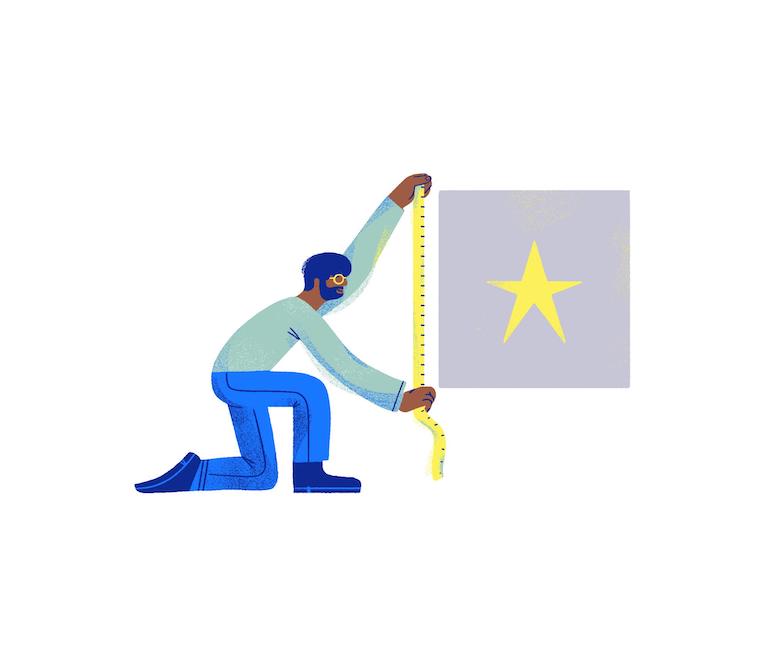
With so many choices in the Shopify App Store, standing out to merchants is a constant challenge. How do you ensure that your app gets found by the users who need it?
The truth is, standing out from the competition begins even before you build your app. By choosing your niche carefully, cultivating a deep understanding of your target users and competition, and properly testing use cases, you’ll be equipped to set yourself up as the prime choice for merchants.
1. Conducting research: Identifying your niche
The first thing to understand about your app is where it fits within the wider app store context. Whether you already have an app idea in mind, or are looking for potential gaps to fill, having a clear picture of what’s already available to Shopify merchants will help you differentiate your app, which is the secret to standing out.
Merchant pain points
Successful apps target specific merchant pain points. For Warner Liu, co-founder of the app development company Hextom, there’s no point investing time in trying to get more downloads if you haven’t first confirmed that your app is addressing a real merchant pain point.
“The first step is to verify the market fit for your app, especially as a new developer,” Warner says. “If the app isn’t solving a real problem and you get 20 people to visit your page, you’re just increasing your bounce rate.”
For Warner, solving merchant problems means investing in conversation.
“It’s better to talk to merchants in person. Not all app developers are merchants. Even for us, we never got a chance to run a real store, so we never had any first-hand experience and had to learn from our users. Now it’s much easier—there are meetups around the world, so a developer can go to the local meetup in their city and talk to a bunch of merchants. You might get 30 users, which is not a big number, but that’s the seed of people you can get more opinions and ideas from to refine your app.”
It’s better to talk to merchants in person.
If you aren’t solving a constant, painful problem for merchants, your app simply won’t get traction. In addition to Warner’s suggestion of attending meetups, there are a number of ways to collect this information:
- Check out our forums at Shopify Community for common merchant frustrations. The community forums are an excellent source of information on stumbling blocks merchants run into. For a good example, check out how an app developer jumped on this opportunity to build an app for a specific request. Keep an eye specifically on the Shopify Apps board for not only app ideas, but also great opportunities to provide feedback and promote your app.
- Host user interviews, a contextual inquiry, and surveys to collect feedback. While these are powerful tools to test your app, surveys and interviews can also help you gauge what your target audience is struggling with. In interviews, use open-ended questions to facilitate conversation. In surveys, use multiple-choice questions to keep things focused and measurable, and open-ended questions for anecdotal feedback.
- Listen in where merchants talk. Search around for merchant communities (such as the Shopify subreddit) and places where merchants ask questions (like the Shopify topic on Quora). Like Shopify Community, these are great places to listen in on common frustrations.

In all your research, you should be taking notes of the repeated pain points:
How common are they?
Are there already solid solutions available in the app store?
Can you build something that eases these frustrations?
Understanding what merchants struggle with will help you understand where your solution fits in.
App store categories
If you want to be really strategic with your business, the Shopify App Store itself offers a great opportunity to identify underserved niches. By digging into the different categories and subcategories in the app store, you’ll start to see that some areas are completely saturated, while others offer lots of opportunity.
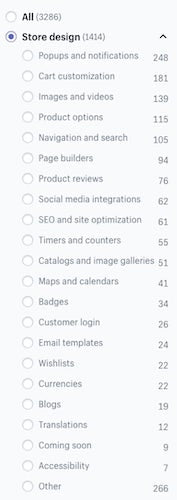
Narrowing your scope and finding a niche you can make your own are two of the most powerful ways to stand out in the Shopify App Store. Almost every single category has a subcategory that you have a chance of disrupting. Instead of competing against a massive list of established apps, focus in and find the areas where you see lots of gaps in the market. And if you happen to run a search that turns up zero results, you may have just found a huge gap in the market that your app can fill.
Target audience
Finally, and perhaps most importantly, you need to define your target audience.
Your target audience can’t simply be “everyone”—if you build for everyone, you build for no one. Instead, a narrower target audience will help you build specifically for their problems, concerns, and challenges.
"If you build for everyone, you build for no one."
Identifying a focused target audience helps beyond the design and development of your app. When it comes time to market it outside of the Shopify App Store, you’ll find you have more of an idea of where to target your potential users. Blog post topics, social media marketing, and even events become easier to choose when you know exactly who it is you’re targeting.
There’s more to consider here than just your ideal merchant. Many merchants have technical folks working for them, and others are building partnerships with agencies to create ecommerce solutions. When considering who your audience consists of, make sure to not only think about the merchant themselves, but the technical advisors that work on their store’s backend as well.
In his article about how to conduct market research for your app, Charlie Casey of LoyaltyLion shares the importance of having a real understanding of who you choose to target.
“In the early stages of research, you’ll want to target the decision makers in the business, so that you can understand their strategy and what success looks like for them,” Charlie says. “However, when it comes to the challenges around execution, you’ll need to speak to the person actually executing, whether it’s the marketer using your app or the developer helping them customize it. Ensure that when you start digging into the merchant’s operational challenges, you get direct feedback from those logging into and using your product every day.”
When it comes to the challenges around execution, you’ll need to speak to the person actually executing, whether it’s the marketer using your app or the developer helping them customize it.
2. Conducting research: Understanding the competition
Now that you have a good idea of what kind of app you’re building and the people who will be using it, it’s time to get an understanding of the competition in your niche.
Collecting this information is key, and once you know how your competitors operate, you’ll be in a better position to stand out from the crowd so your app can succeed.
Run a competitive analysis
Knowing how to do a competitive analysis is a major step to starting your app development out in the best possible way. It affords you a look at not only your competition’s product, but also at how their business operations (like marketing, for example) can impact your own business.
When starting a competitive analysis, you’ll want to begin by identifying both your direct and indirect competition.
- Direct competition: Apps that could be seen as an alternative to your own
- Indirect competition: Apps that solve the same problem as you, but in a different way
In your competitive analysis, you’ll want to dig into your direct competition. To explain why, let’s look at an example.
Let’s say you want to create an app that allows merchants to send a gift to specific customers. You check the app store and find another app that lets merchants create contests and giveaways. Both apps solve the same problem—gift giving—but the needs of the user differ.
Your app gives merchants a way to give gifts on a one-to-one scale, while your competition gives merchants a way to give gifts on a one-to-many scale. Since your users are after different things, you aren’t direct competitors.
If, however, there’s an app in the app store that already gives merchants the ability to send gifts to specific customers, then they’re your direct competition—and they’re who you want to focus on for your competitive analysis.
Once you’ve compiled a list of your direct competition, you want to answer the following questions about them:
- How does their product work? What are they offering? Your best bet here is to download their app and explore it.
- How many languages is their app offered in?
- What are their sales channels? Are they partnered with any agencies?
- What are their reviews like? Are there any common requested features?
- How do they market? Do they have a blog? How often do they post? Are they active on social media? What’s their customer engagement? How about SEO?
- What’s their support process? Are they easy to get a hold of?
- What does their SWOT analysis look like (strengths, weaknesses, opportunities, and threats)? Where are they better than your proposed product? Where are they weaker?
- How much are they charging for their product?
Hubspot has created a great guide for doing a full competitor analysis. Though it is time-consuming, collecting all of this information will help you when it comes to the most important part of making your app stand out—differentiating it.
Translate your app
To get more downloads in the Shopify App Store, the real key is in differentiation. You want to be visibly different from the competition, an obvious better choice. Now that you have in-depth knowledge on your niche and your competition, you’re equipped to make decisions that set you apart from everyone else.
How you differentiate your app will vary greatly depending on your niche, but one universal step you can take is to build multilingual Shopify Apps.
The Shopify App Store is available in 15+ languages, and allows developers to have translated app listings for as many different languages as their apps are available in. Translating your app into those languages makes you a go-to option for merchants around the globe.
By using approaches like pseudo-localization to build your app with translation in mind, UTF-8 for encoding emojis to work globally, Shopify’s React il8n yarn package for elements that appear differently globally (dates, addresses, and timezones) and Polaris’s internationalization guide, you open up your potential user base from just English speakers to millions more.
Translated app listings will also get surfaced directly to merchants browsing the app store in the language your app is in. In addition, you can also get more direct merchant exposure through one of the country-specific app collections.

Shopify’s Global Economic Impact Report highlights the opportunity of global: for example, in 2018, apps developed by Shopify Partners in India have been used by over 280,000 merchants globally. Shopify Developers around the world are taking advantage of this opportunity. Thomas Bertrand, founder and CEO of Shopify App Ship&co, saw exactly how the international opportunity can help grow your app downloads when Ship&co launched their app in French and Japanese.

“Being able to publish our app in these three languages on the Shopify App Store really helped us to get new customers in different countries,” Thomas says.
The results of translating your app speak for themselves. Ship&co launched their translated app listing the week of June 24th. Almost immediately, their merchant growth began to spike:
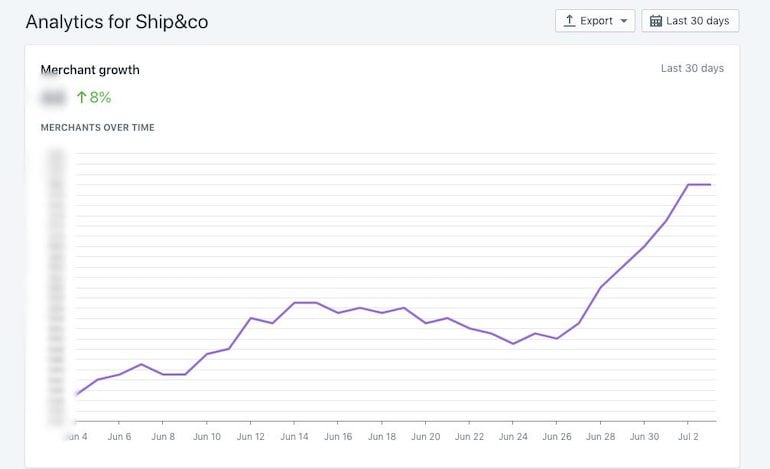
Translating your app and your app listing page improves your visibility and market fit, bringing your app to new markets and new users. It’s a worthwhile investment in the future growth of your app.
Don’t forget that if you translate your app, conducting international market research to understand the context you’ll be working in is vitally important to success.
3. Conducting research: Testing your app
To get your app listed on the Shopify App Store, you must submit it for review to Shopify’s QA team. And before you submit it for review, you must user test your app.
But testing is important for more than just having your app listed—thorough testing also helps ensure that you’ve done everything in your power to provide merchants with a great user experience. Your app should look great, and provide the expected outcome to your users.
Instructions for testing your Shopify App can be found in the docs, but it’s important that you invest time in user testing your app as well. Testing now will save you headaches down the road. Once you’re listed in the app store, reviews will become vitally important to generate more downloads. Any negative experience a user has will threaten those reviews.
4. Conducting research: Additional resources
- Research 101: How to Conduct Market Research for Your App
- Conducting User Interviews: How to do it Right
- How to Learn More About Your Users with a Contextual Inquiry
- International Market Research: What You Need to Know Before Working with Clients Across Borders
- How to Build Multilingual Shopify Apps
- User Testing Your Shopify App: Public App Use Cases You Should Test
- Don't Get Lost in Translation: What is Pseudo-Localization and Why You Should Care
- How to do a Competitive Analysis That Drives Results for Your Clients
Build apps for Shopify merchants
Whether you want to build apps for the Shopify App Store, offer custom app development services, or are looking for ways to grow your user base, the Shopify Partner Program will set you up for success. Join for free and access educational resources, developer preview environments, and recurring revenue share opportunities.
Sign upPart 2: Getting found in the app store

The Shopify App Store will likely be a top source of traffic for your app, meaning it’s vital that you optimize your app for the app store from the very start.
To do so, you need to understand how key features like the app store search engine and recommendations algorithm work.
For a deeper understanding of these two processes, check out our presentation from Shopify Unite 2019, where Shopify Senior Developer Joey Freund and Product Lead Xinyi Zhao walk through the details of each.
1. Getting found in the app store: The app store search engine
The Shopify App Store search engine is designed to surface the most relevant apps to merchants. One of the biggest takeaways from Joey and Xinyi is that keywords are used to determine that relevance—meaning that you need to understand which keywords best apply to your app, and start adding them to your app listing page.
Keywords are words and short phrases that merchants are likely to use when searching the app store for a solution to a specific problem. For example, if a merchant needs help tracking orders, they’ll likely search for one of the following phrases:
- Order tracking
- Order status
- Tracking
- Shipping tracking
- Shipment tracking
- Shipment status
- Shipping status

Spend some time brainstorming which keywords are most relevant to you. A tool like Google’s free Keyword Planner will help you in this brainstorming process.
In his article on app store success, Jonathan Zhao, Product Lead at Shopify, shares advice on choosing strong keywords.
“Keywords are the words and phrases closely related to your app, and are what merchants are likely to use when searching the app store for a specific solution,” he explains. “A word of caution, though—using too many keywords, especially irrelevant ones, can hinder your success. Don’t have too many keywords—it’s best to keep it laser-focused.”
Using too many keywords, especially irrelevant ones, can hinder your success. Don’t have too many keywords—it’s best to keep it laser-focused.
Remember that less is more—you don’t want to target all keywords; instead, aim for those that are the most relevant to your app. Merchants will search for solutions to very specific problems, and you want your keywords to speak directly to those problems.
You’ll put these keywords to work when you optimize your app listing page, but they should also be used to inform the name that you give your app, since it will be the first thing that potential users see in the app store.
2. Getting found in the app store: Understanding recommendations
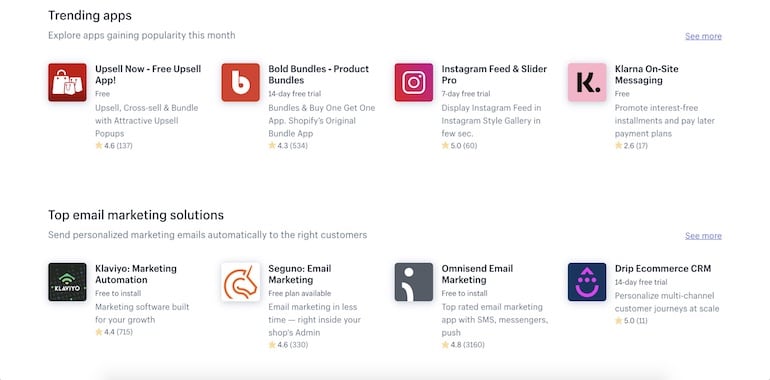
The recommendation engine is designed to provide merchants with the most relevant app recommendations for their particular business. With the many apps already in the app store, this helps merchants filter out which apps are best for their needs.
Recommendations are surfaced in various ways, including a collection on the app store homepage that is personalized to the individual merchant. This is one of the highest converting collections featured on the homepage, making it vital to understand how to get included in relevant recommendations.
There are three main ways you can ensure your app is prepared for the recommendation engine:
- Have accurate install requirements. The recommendation engine will only recommend your app to merchants who meet these requirements.
- Maintain positive reviews. Your reviews will impact how often your app is surfaced. Learn more about reviews below or check out our tutorial on best practices to reply to reviews.
- Consider location. Apps that work in specific regions will be surfaced to merchants in those regions. Be sure you’ve highlighted in which regions your app works best.
3. Getting found in the app store: Additional resources
- How to be Successful on the New Shopify App Store
- Our docs on being successful in the Shopify App Store
- Getting featured on the Shopify App Store
Part 3: Optimizing your app listing page

Your app listing page is the heart of your app’s presence, and your opportunity to brand your Shopify app to make your app stand out. The app listing page is the make or break moment with users—it’s where they will go to find the information they need to make the decision about whether to add your app to their stack. The listing page is also the main source of information for both the app store search engine, and the recommendation algorithms. It’s where you should concentrate time and resources on creating something great.
Every inch of your app listing page is an opportunity to share your brand, build trust with users, and communicate with your audience. Every one of these opportunities should be used to convince your target audience that your app is the best solution for their needs. Below, we look at the mediums available to you, and how you can use them to maximum effect.
A note about translating your app listing page: We talked about the huge opportunity that translating and localizing your app listing page provides above. If you translate your app, it’s important to create translated and localized app listing pages as well (however, please note that any listings you create for languages that your app doesn’t support will be removed from the Shopify App Store).
The information below can be applied to your app listing pages in any language.
1. Optimizing your app listing page: Visuals and video
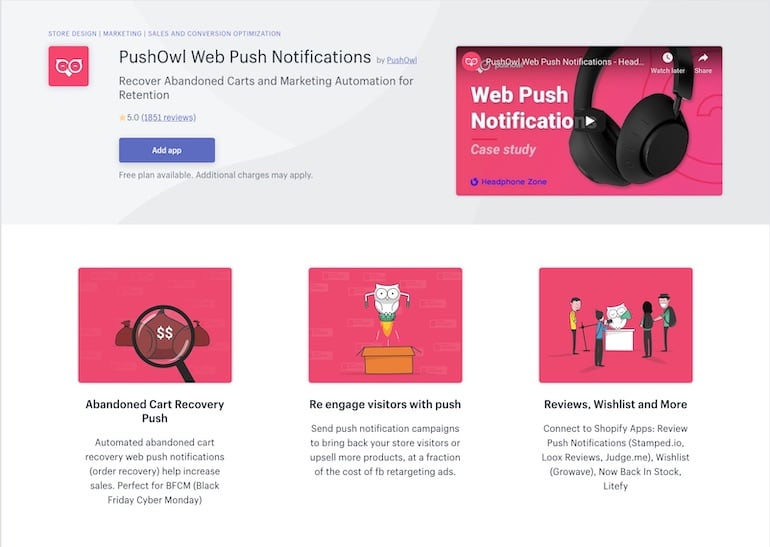
Visuals and video play a key role on the app listing page—in fact, there is space directly in the header for developers to include a video. There’s also space directly under the header for visuals and key benefits.
A great video should promote your app and its features, but remember that its goal is not to be instructional. Instead, you should use the video to highlight key value points and explain to merchants why your app is a great fit for their needs.
Some general guidelines to keep in mind for your promotional video:
- Keep video length to two or three minutes to keep users engaged and interested.
- Limit feature demos to 25 percent of the overall video—the focus should be on the benefits of your app, not how to use it.
- Don’t include third party logos or elements, even if your app integrates with those companies. You want to be mindful of copyright infringement.
If you don’t have the resources in-house to create a strong promotional video, consider outsourcing the work. Websites like UpWork or Fiverr are good places to look, and the Shopify Experts Marketplace is a great place to find Shopify Partners who can help.
We’ll get to the copywriting below, but visuals play an important role with your app listing page, too. Any visual branding should be consistent with what you’ve already used in your video, and should connect with any key benefits that you’ve chosen to highlight. Many brands (like PushOwl above) use digital illustrations to personalize their brand. Remember to keep your visuals tidy, memorable, and unique.
Unsure of where to start? Use the image templates below as guidelines for sizing your visuals, helping you simplify the design process.
2. Optimizing your app listing page: Key benefits
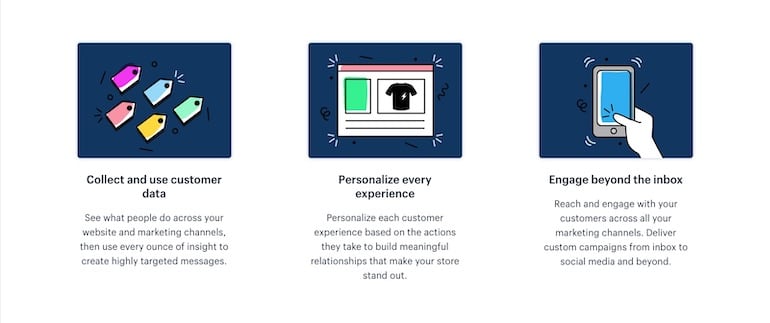
The Key benefits section is your opportunity to tell users about your value propositions.
Your value propositions are the promises you make users about the value that your app delivers. They highlight the benefits of your product, and explain why it’s different from your competitors (another reason why the competitor research that we covered above is important).
Your value propositions should be clearly communicated and relevant to your audience. This is the time to learn how to improve your writing.
A strong value proposition includes, at minimum:
- A headline that explains the end benefit to your users in one sentence
- Two or three sentences explaining how your product creates that benefit
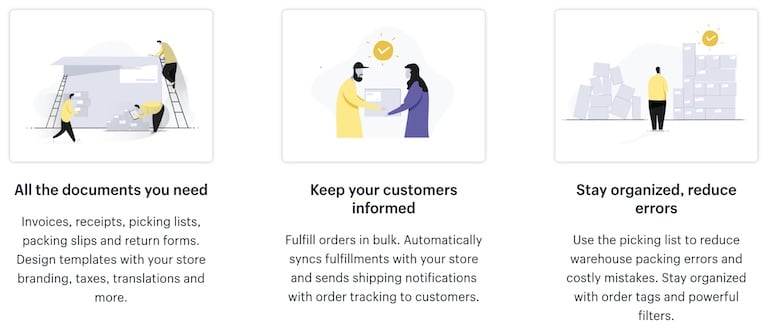
The value propositions that you highlight in the Key benefits section of your app listing page will also guide how you craft your Detailed description. Think of your value propositions as the key messages that you’ll want to keep coming back to in all of your brand communications.
"Think of your value propositions as the key messages that you’ll want to keep coming back to in all of your brand communications."
3. Optimizing your app listing page: Detailed description
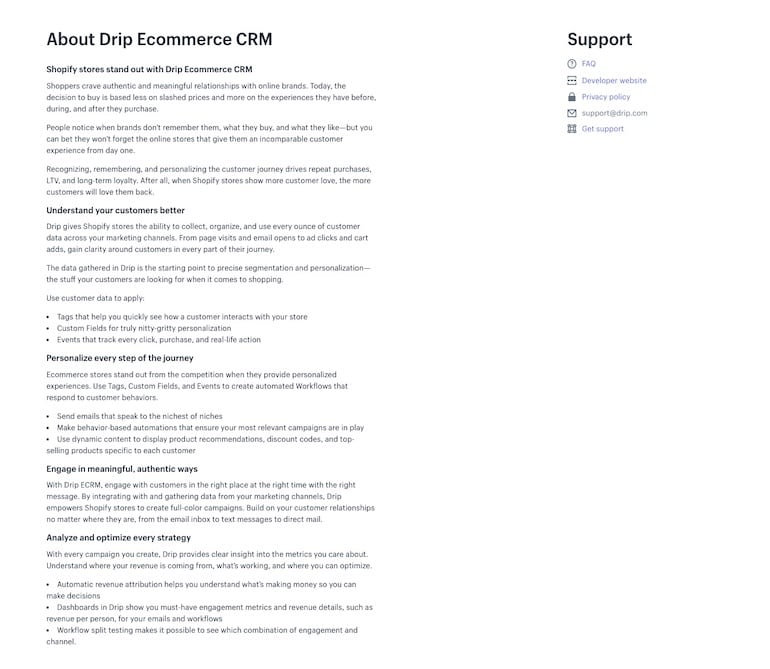
The Detailed description section of your app listing page is where you can really make your app shine. It affords you the space (2,800 characters) to build on your value propositions, explain your key features in detail, and show how your app solves a very specific merchant problem.
In addition, the description is another place from where the search and recommendation algorithms draw information. Therefore, you want to make sure that all the information here is clear, concise, and relevant.
Applying your keywords
The Detailed description is where you want to apply the keywords that you identified earlier, which enables the search and recommendation algorithms to find them.
Some general guidelines for applying keywords to your description:
- Follow the principles of on-page SEO to help surface your app in relevant searches.
- Don’t keyword stuff (the act of using your keyword too much/unnaturally in your writing). Your keyword should flow into your description naturally.
- Do use variations of your keyword—order editing and order email editing, for example—throughout, but don’t worry about singular versus plural. The search engine accounts for that automatically.
- Test and optimize your app listing consistently to ensure you’re targeting the best keywords for your product.
Copywriting
Since this is your chance to sell users on your app, your writing should be as clear and easy to understand as possible.
To help accomplish this, keep the following in mind:
- Keep it short but informative. Deliver the most important information readers need to know quickly.
- Use clear and simple language. Don’t say ‘utilize’ when you can just say ‘use,’ for example.
- Read your writing out loud. It sounds silly, but you’ll catch awkward sentences and overused words better that way.
- Edit, step away for a day or two, and edit again. Then have someone else edit. Typos and bad spelling will come across as unprofessional, and can threaten your credibility with users. Hire a freelance editor if necessary.
When writing the copy for your Detailed description, understanding what your competition is doing is also important. In her article on optimizing their app listing page, Michelle McNamara of Shippo explains how they considered their competitors’ copy when crafting their own.
“We took a look at other shipping and fulfillment apps in the Shopify App Store to compare value propositions and analyze their messaging,” Michelle says. “We wanted to make sure the copy was clear and concise, while also making sure our messaging was up to date and relevant from a competitive perspective. Once we’d finished reworking it, we had much cleaner copy.”
We wanted to make sure the copy was clear and concise, while also making sure our messaging was up to date and relevant from a competitive perspective.
Remember that what is written on your app listing page is the first, and very often only, interaction potential users will have with your product before making the decision to install. You have this opportunity to win them over—let the benefits of your app shine through with clear, concise, and professional writing.
Further instructions on what can and cannot be included in the description can be found in our docs.
4. Optimizing your app listing page: Building trust with users
In addition to building your brand and communicating your value propositions, the app listing page in the Shopify App Store is prime real estate to establish trust with users. By communicating with users upfront about more sensitive issues such as pricing, privacy, and support, you can avoid nasty surprises down the road and build a loyal user base.
Clearly communicate your pricing strategy
Choosing the right pricing model is one of the most sensitive and important decisions you’ll make. It’s also one of the toughest conversations you’ll have with users, meaning it’s important to be as clear and concise as possible to help them understand exactly why they’re paying for your app, and what they’re getting in return.
How you charge for your app will depend on your unique business context. There are three types of transactions used between developers and merchants:
- AppPurchaseOneTime: For items or services that are billed for only once. Each purchase needs to be approved by the merchant.
- AppSubscription: For items or services that are billed on a recurring basis. The subscription needs to be approved only once by the merchant, and any recurring charges are billed automatically. Usage records are billed with app subscriptions.
- AppCredit: For purchase adjustments. App credits are redeemed on future app purchases. Shopify deducts the purchase adjustment from your partner account’s future payouts.
You can learn more about your billing options and how the Shopify app billing cycle works, including Shopify’s Billing API in GraphQL, by reading our developer docs.
Once you’ve selected how you will charge for your app, you need to communicate that strategy to merchants. In the Pricing details section of your app listing page, you’ll be given three different billing options:
- Free to install: Merchants don’t pay anything to install your app.
- Recurring charge: Merchants are charged every 30 days or every year that they have your app installed. When you choose this option, you can add extra information about how your monthly and yearly plans work.
- One-time payment: Merchants are charged a single fee for installing the app.
An important note: any of these billing methods can be combined. Since you want to be clear about pricing to help gain merchant trust, you should be upfront about any additional or in-app charges.
For example, if you charge a one-time install fee, and then an additional charge at certain increments (for example, $2 per 100 orders), you should select One-time payment and explain your ongoing charges in the Additional charges section. Be sure to clearly describe what these additional charges are and the benefit to users.
You can also set up a yearly discount for apps on a recurring charge plan. Having users purchase your app for a full year helps your retention rates and embeds your app into your user’s day-to-day activities, which can make your product indispensable. To encourage this, you can offer discounts to those valuable users that purchase your app for a full year. When you select a monthly charge under the recurring charge option, you can add this discount.
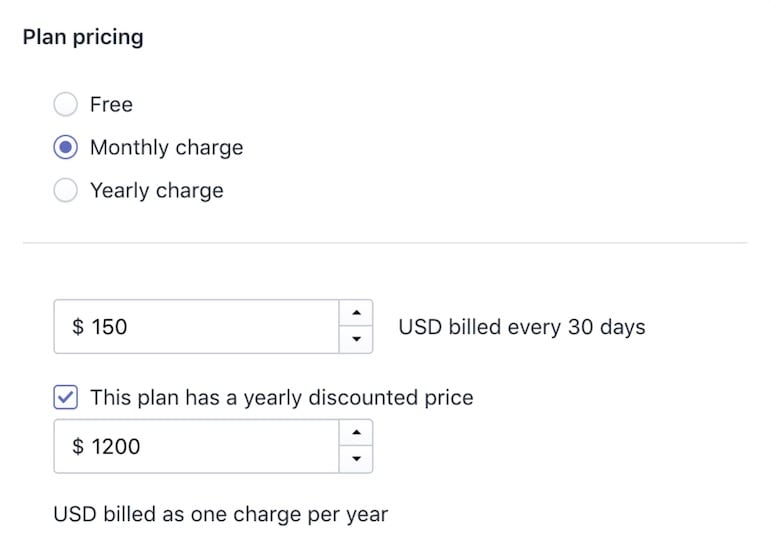
To help merchants understand and trust you, there are additional steps you can take to communicate your pricing strategy:
- Offer a free trial. With recurring charges, you have the option of offering a free trial. This is a good way to let merchants experiment with your app before making the decision to purchase. Be sure that your trial is long enough for merchants to actually test your app—we recommend at least 14 days.
- Include all details. The Plan details section lets you name and list features available in each of your plans. Be clear about the benefits available at each plan price. List each feature on a separate line with no bullet points—when your list is rendered in your app listing, bullet points will be added.
- If necessary, include an external pricing page. Your app listing page has room for four pricing plans. If you have more than that, you can link to an external pricing plan. Add the link to the Additional charges field of the highest-priced plan on your app listing. A good note to add is, “Additional plans available. See our pricing page for details.”
Your pricing model is one of the most important aspects to consider, and how you communicate it to users will go a long way in determining the trust they have in you, and in turn the success you experience on the Shopify App Store. Be clear and upfront about charges, communicate concisely what those charges are, and give merchants resources to further understand your pricing structure.
Include your privacy policy
Including a privacy policy on your app listing page is mandatory, and goes a long way in letting merchants know that their data will be protected. By being transparent about how your app uses merchant data, you will help users rest easy knowing that you take privacy seriously.
If you have users in Europe, check out our article on what app developers need to know about GDPR compliance. For more guidance in crafting your privacy policy, download our privacy policy template below.
Share FAQs and support links
Answering frequently asked questions and providing resources for support is an important step in building trust with users. Your app listing page includes the following options for including support resources:
- A link to a FAQ page: This allows you to link directly to an FAQ page on your website that addresses common user questions. This is optional, but highly recommended as it helps merchants attempt to address issues on their own before turning to your support team.
- Support for other languages: If you have a translated app, you can also include links to support in those languages. If you don’t have support in those languages, you must note in your listing that support is only available in English.
- Email: This is the email that merchants can contact with support questions.
- Website: This URL should direct users to an informational landing page where merchants can learn more about your app. It cannot link to a promotional page.
- Phone: Including a phone number is a powerful way of assuring merchants that they can access support when they need it. During your app review process, a member of Shopify’s QA team will call this number to ensure it’s functioning.
We’ll dive more deeply into the world of supporting users after they’ve downloaded your app later in this article, but if you’re keen to learn more, read our article featuring advice from fellow Shopify Developers on how to 10X app support.
5. Optimizing your app listing page: Managing reviews
Reviews are an incredibly important component of your app listing. They can impact your search ranking, the recommendation engine, and your eligibility for Staff Picks, the featured apps section on the app store homepage.

Reviews are also a large determining factor when merchants are deciding whether to download an app. All of this means that managing your reviews is an important part of getting more downloads on the app store.
To leave a review, a merchant must have your app downloaded on their store. Once they’ve done so, they are able to leave a one to five star rating as well as a comment. If a merchant uninstalls your app, they are still able to leave a review for up to 45 days after their uninstall.
There are three main considerations when it comes to managing reviews:
- Asking for reviews: Make sure you understand the right way to ask users for reviews. You can ask users for reviews, as long as you do not ask for positive reviews. Use neutral language to encourage users to share their feedback on the app store. Be sure that you do not ask for reviews in an intrusive, incentivized, or biased way, as you can be subject to governance review and removal of your apps from the app store. Learn how to get reviews for your Shopify apps the right way to build trust amongst potential new users and to build your user base.
- Replying to reviews: A strategy to reply to reviews helps you engage with merchants and address their needs, while simultaneously showing other merchants how communicative and helpful you are. Your responses should be consistent with your brand, and personalized to each merchant. When you reply to a review, the merchant is given the option to edit their review, which means that replying to negative reviews can be a powerful way of mitigating their impact.
- Dealing with negative reviews: When a merchant leaves a negative review addressing a bug or flaw, it’s a good opportunity for you to engage the user and address the problem head on. This can help retain the merchant, fix the issue for future users, and demonstrate your willingness to work with them.
6. Optimizing your app listing page: Tracking your listing
With all the work you’ve invested in building and optimizing your app listing page, you want to ensure that you’re tracking the results. Follow the instructions in our docs to set up Google Analytics properly on your listing.
If you want to go a step further, Shopify app developers Rewind have put together a guide on how to track the source of installs in your Shopify App Store listing. This guide not only walks through how to enable Google Analytics on your listing, but also how to track clicks on the Add app button itself. Tracking your app metrics will help you understand what’s working and what isn’t.
7. Optimizing your app listing page: Additional resources
- Give Yourself Design Superpowers with Digital Illustrations
- A Step-by-Step Guide on How we Optimized our App Listing in the Shopify App Store
- 10 Ways to Establish Trust on Ecommerce Sites and Apps
- Why and How to Improve Your Writing as a Web Designer or Developer
- How to Brand Your Shopify App to Earn More in the App Store
- Choosing the Right Pricing Model for Your App
- Getting Paid: An Overview of Shopify App Billing Cycles
- Shopify’s Billing API in GraphQL: What App Developers Need to Know
- What App Developers Need to Know About GDPR
- 8 Growth Metrics Every App Developer Should Track
- Replying to Reviews in the Shopify App Store
Part 4: Marketing your app
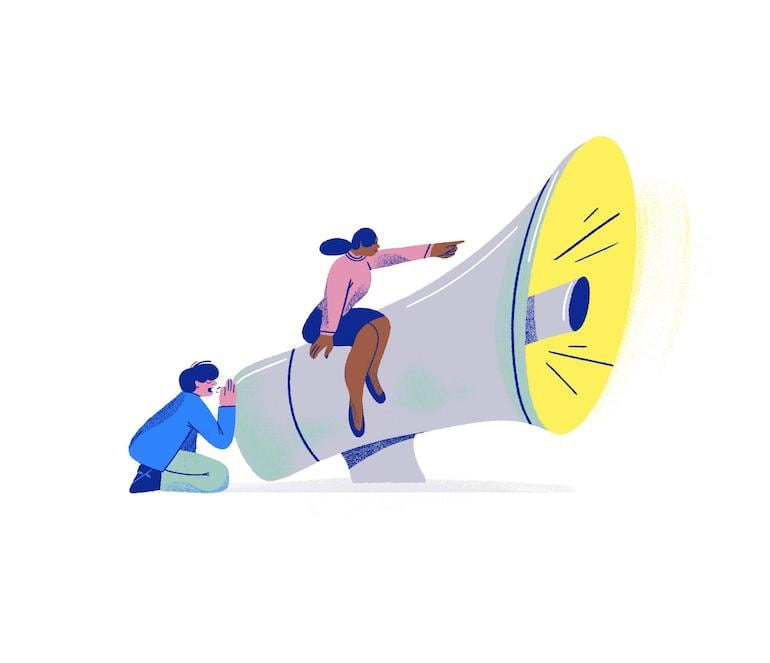
You’ve researched your target audience, your niche, and your competition. You’ve learned how the app store search and recommendation engines work. You’ve optimized the visuals and descriptions on your app listing page, and used them to build trust with users. You’ve created a robust strategy for addressing app reviews. Now, it’s time to share your app with the world.
While the Shopify App Store is a powerful marketplace, you are not limited to this marketplace when it comes to marketing your app. The marketing you do outside the app store is in fact largely responsible for defining how your app will perform, and can help you rank better in the app store itself.
Marketing strategies can take many different forms, all of which play a role in establishing your app as the right fit for your target users. In this section, we’ll look at the steps you should take to build a strong marketing plan and gain traction for your app.
1. Marketing your app: The marketing funnel
The basics of marketing revolve around something called the marketing funnel. The marketing funnel maps how your audience goes from strangers, to users. The basic marketing funnel has five stages: awareness, consideration, conversion, loyalty, and advocacy.
When it comes to app marketing specifically, conversion signifies the moment that a user completes the steps in adding your app to their store. As the loyalty and advocacy phases are post-install, for the purposes of this article we won’t focus on them (but this doesn’t mean they aren’t important—both are key parts of retention, and should be part of a post-install nurture strategy).

Before we get into more detail, here are some simple definitions:
- Awareness is when a potential user becomes aware of your company and app.
- Consideration signifies a potential user beginning to consider if they should install your app.
- Conversion is when the user makes the decision and installs your app.
Marketing plays a role at all stages of the funnel, but can especially be applied to these three stages as a key part of how to get more app installs. Your goal is to capture a large amount of qualified traffic (traffic that has the potential to convert), and nurture them through the funnel to conversion.
As mentioned in the research portion of this guide, remember that potential audiences can include more than solely merchants.
Gavin Ballard, founder and CEO of Shopify Partner agency Disco, explains in his article on how to market an app that hired help can also land in your marketing funnel.
“Don't forget that Shopify merchants are often acting on the recommendation of technical experts such as freelance developers, agencies they've engaged, or their own in-house development teams,” he says. “The larger the merchant, the truer this becomes.”
Lean on the research you conducted to identify who your target audience is, and who the influencers and decision makers are. It’s important to get this research right from the start, as it will inform your wider marketing strategy, including the types of merchants—and potentially agencies, freelancers, and developers—who will be installing your app. Putting the effort into your research now will help you ensure that you aren’t missing any potentially impactful segments.
2. Marketing your app: Marketing channels
Marketing is a big world, with countless different approaches that can all lead to varying degrees of success. Understanding how your bandwidth, abilities, and resources play into creating a marketing strategy is key—but first, it’s important to understand what channels are available, and how they work.
Below, we look at the different channels you can leverage to market your app, and how to effectively put them to work.
Blog
One of the most effective tools at your disposal is content marketing via a blog (we’re biased, but it’s true).
A blog carves out a place on the internet where you can drive qualified traffic (traffic that has the potential to convert) and establish yourself as an expert in your field. A blog also provides an excellent opportunity for lead generation. Lead generation is the collection of high-potential contacts that you can enter into a nurture campaign to help move them down the funnel to conversion.
How does this work?
First, armed with an understanding of the problems that your target audience faces (from the great research you did at the start of your project), you can formulate blog topics that speak to specific issues among target users.
For example, if your app facilitates Facebook marketing, you probably realize that your potential users are merchants struggling with social media marketing. From that, an impactful topic for a blog post may be ‘10 Best Practices for Marketing Your Store on Social Media.’ You write an excellent post that addresses a common pain point among your target user, establishing yourself (and, therefore, your app) as a trusted solution to merchant problems.
A strategic blog post should also include a tactic for lead generation. Most often, this means including valuable, downloadable content that users trade their email address to access. This content should be high quality enough that readers are comfortable exchanging their contact information. Those email addresses are then added to your email tool to be used in drip campaigns—explained below.

Once you have your post published, it’s important to distribute it. Much like your app listing page, your blog post should be optimized for search using on-page SEO tactics. This will help drive organic traffic to your blog post, increasing your exposure.
In addition to optimizing your post for search, you also need to actively share it. The internet is a busy place, which means that publishing your post and hoping for the best isn’t a viable approach. This brings us to the next piece of the marketing puzzle—social media.
Social media
Social media is a powerful platform for connecting with users, building communities, and sharing information.
At the most basic level, it’s a place to build a following and share updates such as new blog posts. When used strategically, you can grow your business with social media by creating a community to bounce ideas off of, share insights with, and form mutually beneficial relationships on.
Social media is a two-way street—while you should share your content and updates specific to your business, it’s important to remember that listening to users, participating in conversations, and offering advice and guidance when relevant are equally important.
As Warner of Hextom shares, the feedback cycle of social media can have benefits beyond getting eyes on your app.
“You can use your audience to get ideas, and those ideas might inspire you to add a major feature to your app,” Warner says. Social media allows the kind of one-on-one conversation that can highlight missing features, or even a gap in the market for a new product.
“It costs time to build up those valuable audiences, so start sooner than later,” Warner continues. “This is one thing we actually regret a little bit; we didn’t focus a lot on social media. But now we think it’s quite important to have an audience, because that’s basically your innovation source.”
Forums
Like social media, forums are a place to share content, offer advice, and connect with users. Also like social media, it’s important to offer value, not just promotion. Merchants and other Shopify Partners use Shopify Community to seek guidance. Offering your expertise for free is a powerful way to establish your leadership in the industry and gain user trust.
As discussed in our section on finding merchant pain points, Shopify Community is a fantastic source of exposure for your app. You should keep an eye on the Shopify Apps board for opportunities to offer support and, when appropriate, to link back to your blog or website.
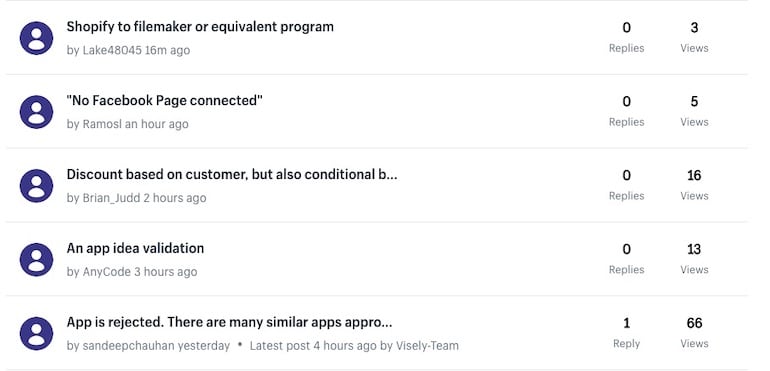
In addition to Shopify Community, Shopify-specific forums around the internet offer chances for you to get your voice out there and offer great insights to users. The Shopify subreddit, for example, is a constant source of merchants seeking advice. Offering guidance and thoughtful shares of your content is a good way to build brand recognition and drive traffic to your website.
Email marketing
Once you’ve invested in creating great content, driving readers to it, and collecting email addresses, you should start to amass a viable email list. This email list is a powerful tool—it’s a direct line to your users, and should be treated like gold.
One important thing to remember: before you send any marketing communications, you must ensure your contacts explicitly opt in to allowing you to send marketing emails to their email address. In several countries, there are strict regulations against sending emails that users haven’t opted into.
"Before you send any marketing communications, you must ensure your contacts explicitly opt in to allowing you to send marketing emails to their email address."
Be mindful of the laws in your and your users’ regions.
Your email list is the best way to communicate with invested readers. Email marketing is a practice all of its own, but there are a number of ways you can start small with your email list. Sending out a message whenever you publish new content is a start, as is sharing any important updates about your product.
When you’re ready to step it up, email personalization and email segmentation are key strategies to begin sending highly-targeted emails to specific users. These tactics allow you to consider what stage of the funnel your users are at, meaning you send them content relevant to where they are in their buyer journey.
Partnerships
Joining forces with other Shopify Partners is increasingly becoming a key determiner of success in the ecosystem. By building connections with other partners, you set yourself up for not only co-marketing opportunities, but also for fruitful relationships that help the longevity, retention, and growth of your app.
In her article on building partnerships, Ruth Even Haim, co-founder of StilyoApps, highlights how under-used this tactic remains among partners.
“Building exposure to new clients is probably your end goal when partnering with anyone,” Ruth explains. “Yet this is something that I see a lot of Shopify Partners, and specifically app developers, miss out on.”
Agency partners can recommend your app to their clients, include your app in store builds, and help your app become the go-to option in your niche. But the importance of partnerships lies not only in the mutually beneficial marketing and growth—it also plays a role in retention.
“If you are app developers, you should aim to integrate with as many other relevant apps as possible,” Ruth advises. “This gives you a huge advantage for customer retention—if a new, cheaper competitor comes along, your clients will think twice before moving to a service that doesn’t integrate with the other apps they are using.”
This gives you a huge advantage for customer retention—if a new, cheaper competitor comes along, your clients will think twice before moving to a service that doesn’t integrate with the other apps they are using.
An obvious prerequisite of building fruitful partnerships is connecting with partners, and one of the best ways to connect with partners is to meet with them face-to-face at events.
Events
Up until now, we’ve looked at the different digital marketing strategies you can leverage to get more downloads in the app store. But real-world interactions are vital as well, and being part of the Shopify Partner ecosystem opens the door to a number of popular events.
But your options aren’t limited to Shopify—attending any industry event could be the spark for your business to grow.
As Caitlin Teed, Experiential Marketer at Shopify, shares, the secret to impactful business networking lies in your authenticity.
“The most important rule of engaging with the diverse partner community—and your key to successful networking at these events—is to avoid a sales-y approach,” Caitlin explains. “Start authentic conversations, ask for feedback on your product, and find opportunities in conversations to contribute and be recognized as a thought leader in your space.”
Start authentic conversations, ask for feedback on your product, and find opportunities in conversations to contribute and be recognized as a thought leader in your space.
Caitilin goes on to explain that this has proven successful for a number of other Shopify Partners.
“Many other companies in our app community have found success through this approach. Take Shashank Kumar, founder of PushOwl, for example. He spoke at Shopify Unite about how impactful attending events and marketing through relationship building was for his company—it was hugely successful.”
Watch Shashank’s talk from Shopify Unite above.
Shopify events

Shopify-specifc events give you an opportunity to meet with other partners and merchants who use Shopify every day. Brush up on your networking basics and join us at:
- Shopify Meetups: Hosted locally by partners around the world, these are a great opportunity to connect with others in your region
- Shopify Pursuit: Our international traveling conference series, where the focus is on learning how to grow your business from other Shopify Partners
- Shopify Unite: Our annual partner and developer technology conference
Other events
Depending on your niche, there are hundreds of different conferences, meetups, and events you can attend to widen your network and make connections with potential clients and partners. Some of these include:
- Smashing Conference: A conference about front end development, UX, CSS, JS, and more
- JSConf: Conferences around the world for those who work in JavaScript
- RailsConf 2019: For those who work with Ruby on Rails
- GraphQL Summit: The world’s largest conference dedicated to GraphQL
Whichever kind of event you choose, meeting with others in your industry and vertical allows you to swap notes, key learnings, and expertise with a diverse community of professionals.
3. Marketing your app: Making marketing scaleable
As we’ve seen, marketing is made up of many different channels, approaches, and levels of commitment. As a busy developer, incorporating all of these into your day-to-day might be a difficult task, despite how important marketing is to the growth of your app.
Thankfully, there are different ways to make this lift easier. In this section, we share tactics to make marketing your app faster and easier.
Freelancers
In addition to helping you craft video and visual imagery for your app listing, freelancers are a great resource to help support your marketing activities, especially when you are just starting out.
Upwork is one of the most well-known freelancer marketplaces, and sites like Fiverr and Freelancer are also good resources for finding marketing help. In addition, you can find Shopify Partners in the Shopify Experts Marketplace to help with marketing specifically.
Especially when starting out, investing in marketing help will play an important role in getting the word out about your app.
Automation
Ensuring that all your marketing channels work together to optimize your marketing is key. Marketing automation supports this by combining different software in a strategic way, meaning your users get relevant marketing materials delivered to them when it’s most relevant—no matter what stage of the customer journey they’re at. You still need to create the content, but your automation platform takes care of the rest.
There are plenty of marketing automation software options out there, but there are also ways that you yourself can begin this process before investing. Some options include:
- Cross post blog articles: If you have audiences in various places, it might be worthwhile to cross post your blog articles (for example, by syndicating posts from your own domain to a platform like Medium). This can help increase visibility and reach for your content. Be mindful of using canonical URLs whenever possible.
- Pre-plan social media: Use software like Hootsuite or Buffer to map out your social media strategy in advance. These tools also help you collaborate with your team with built-in functionality for draft posts and approvals, so you’re all on the same page before going live.
- Use a tool like IFTTT: IFTTT (If This, Then That) is a workhorse, allowing you to identify a reaction to take place whenever a trigger action occurs. These triggers and reactions can vary wildly, but it’s a useful tool for marketing. If, for example, you want to tweet a link every time you publish a new blog post, IFTTT can automate that process. Neil Patel shares how, along with some other good ideas for marketing automation, on his blog.
Investing time up front in streamlining your marketing process will give you channels to connect with your audience down the road as it grows—saving you a higher investment and lift as your app begins to get traction.
4. Marketing your app: Additional resources
- Essential App Marketing: 11 Ways to Successfully Promote Your App
- Building Partnerships: Shopify Partners Share How They're Creating Long-term Value
- 3 Simple Ways Your Agency Can Use Content Marketing to Build a Better Brand and Find New Clients
- How Social Media Can Help You Grow Your Freelance or Agency Business
- Email Personalization: Using Analytics to Send Relevant, High Converting Emails
- 5 Ways to Use Email Segmentation to Target Clients and Grow Your Business
- The Power of Community: How Business Networking Can Nurture Your Growth
- Your Network is Your Net Worth: The Basics of Networking as a Shopify Partner
Part 5: Supporting users after they install your app
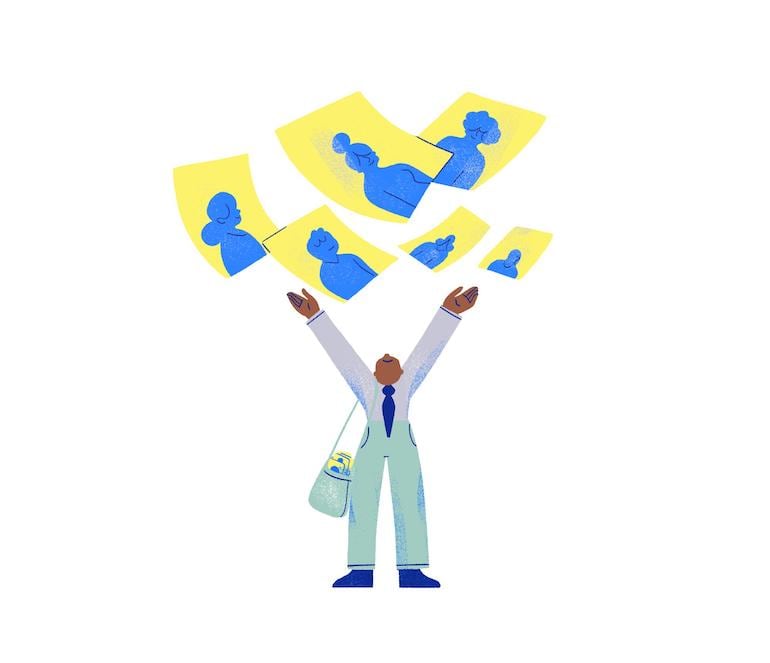
You’ve done a lot of work to get to this point.
You conducted research, determining product market fit for your app and your ideal users’ needs. You’ve optimized your app listing page and are continually testing it to make it better. You’ve invested in external marketing activities and built an audience. And you’ve converted some of that audience into users.
But the work isn’t over.
The real secret of how to get more app downloads is to have an existing user base that’s happy with your product. And that means doing what you can to support and help your users after they’ve downloaded your app.
"The real secret of how to get more app downloads is to have an existing user base that’s happy with your product."
1. Supporting users after they install your app: Build an onboarding plan
Even though it happens post-download, improving your Shopify App’s onboarding flow is a key part of getting more app downloads—happy and confident users become advocates for your app, leading to more happy and confident users. Onboarding helps give your users the tools they need to use your app to its highest potential.
How you onboard users to your app will depend on the type of app, your bandwidth, and the unique requirements of your vertical. Onboarding resources can take the form of videos, guides, and/or graphics that explain how to implement and use your app.
Tom Davies, creator of Shopify App Best Sellers, stresses the importance of keeping onboarding simple.
“Remember that merchants are in general always busy, so make things as easy as possible for them,” Tom says. “Make sure it is always clear what the next steps are to get your app set up. Spend a lot of effort on your documentation. Good documentation is well worth the investment, as it makes your app easier to use and will lower your overall support burden.”
Good documentation is well worth the investment, as it makes your app easier to use and will lower your overall support burden.
Tom shares his tips for creating a good onboarding experience for your users on his blog.
In addition to creating a good onboarding flow and excellent documentation, you need to consider how you get those resources to your clients.
In her article on providing great app customer service, Julia Luce suggests launching an email drip campaign as soon as a new user downloads your app.
“Triggering an email sequence at the time of download puts you at the forefront of the customer experience,” Julia explains. “The email should kick off with a ‘thank you for downloading the app’, followed by next steps and any follow-up questions you’d like to ask. Those can be links to self-onboarding, an attached PDF, or even a phone number to get started.”
Triggering an email sequence at the time of download puts you at the forefront of the customer experience.
Drip campaigns are a great tool that can be automated with the email marketing software of your choice. Essentially, a drip campaign consists of a series of emails sent at predetermined intervals, allowing you to keep up a constant stream of useful, relevant information to your user.

Following Julia’s suggestion above, a very simple drip campaign could follow the following sequence:
- Email 1 (Day 1): Thank you for downloading, with a link to an onboarding guide users can download.
- Email 2 (Day 3): A check-in with users, with a link to the advanced features available with your app.
- Email 3 (Day 5): Information on the support channels you have available, in case users have run into trouble.
- Email 4 (Day 7): Adding users to your blog feed, to keep them connected with your business.
Onboarding is an important part of your app marketing: it gives your users the tools to be confident with your app and use it to the best of their ability, and is an excellent channel for you to further engage them.
2. Supporting users after they install your app: Have a support plan
Having a strong customer service strategy not only helps with retention, but can also improve the reviews you receive from users, positively impacting the app store search engine and recommendation algorithms. In addition to onboarding documentation, make sure you have a robust support process for users.
Since offering good app support is essential, learning more about how to build an effective app support process is something to consider as your app grows. At a high level, some general advice includes:
- Have a single point of contact. This can be a single phone number, or an email such as support@yourcompany.com. This helps you keep your support requests together and organized, and makes it easier to share with users where they can go for help.
- Create self-help documentation. Not only does this reduce the support requests you’ll get, it also gives users the tools to solve problems on their own. Zapier has an excellent guide on creating documentation that can help guide you in this.
- Use simple language. Remember that your users are very often not technical. Don’t make assumptions that they understand any kind of technical language. Start simple, and cut out jargon. “The number one problem that we faced with support was making presumptions that everything we said could be understood by the merchant,” Warner from Hextom says. “Now we keep reminding ourselves to never use technical terms, and to try and use plain, everyday language to make sure the merchant understands.”
- Be nice. If you can make a support request a positive experience instead of a frustrating one, your users will think highly of your product and you. In his article on building an app support process, Kiran Price, Chief Technology Officer at Shopify Partner agency Eastside Co., explains. “Shopify is a pretty friendly platform, and we really like how approachable and readable their docs and support are. We’ve had the best responses when we try to emulate this as much as possible—by focusing on being approachable and pragmatic, and avoiding sounding too corporate or technical.”
Your customer service strategy will help you build a positive reputation for your app and brand, and serve to further bolster the trust that users have in you—helping retention and, ultimately, your success in the app store.
3. Supporting users after they install your app: Additional resources
- 4 Ways to Provide Great Customer Service Immediately After Your App is Downloaded
- How to Build an Effective and Friendly App Support Process
- How to Improve Your Shopify App's Onboarding Flow
- How Cutting out Jargon can Help you Achieve Clear Communication
- Customer Service Strategy: How to Build, Augment, and Scale Your Support Offering
- Expert Advice on How to 10x App Support
Do the work now
There are more than 3,000 apps in the Shopify App Store, and more than one million merchants using Shopify to power their businesses. The opportunity to grow your app development business has never been greater, but making a real impact means putting in the work now.
By taking the time to do your research, build a fantastic app listing page, grow your external audience, and offer great support, you’ll not only know how to get more app downloads, but your app can join the ranks of those used by thousands of Shopify merchants every day.
Build apps for Shopify merchants
Whether you want to build apps for the Shopify App Store, offer custom app development services, or are looking for ways to grow your user base, the Shopify Partner Program will set you up for success. Join for free and access educational resources, developer preview environments, and recurring revenue share opportunities.
Sign upIllustration by Eugenia Mello

